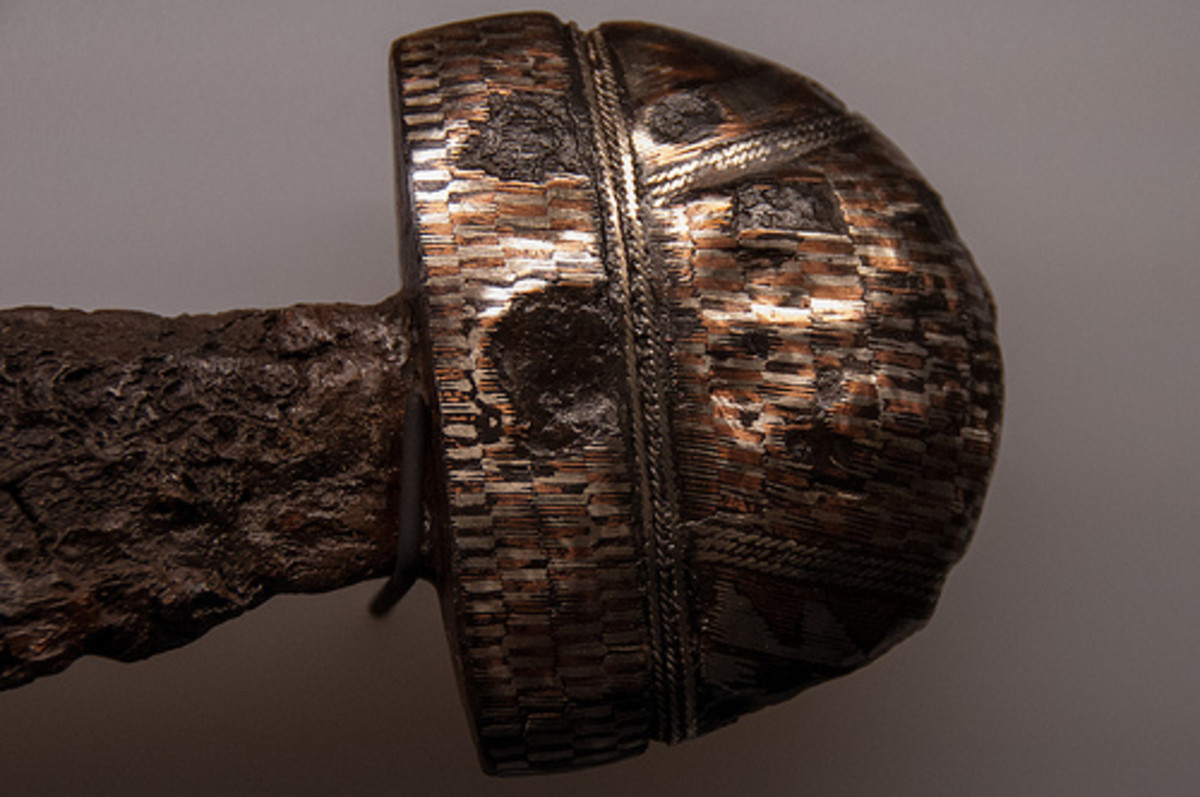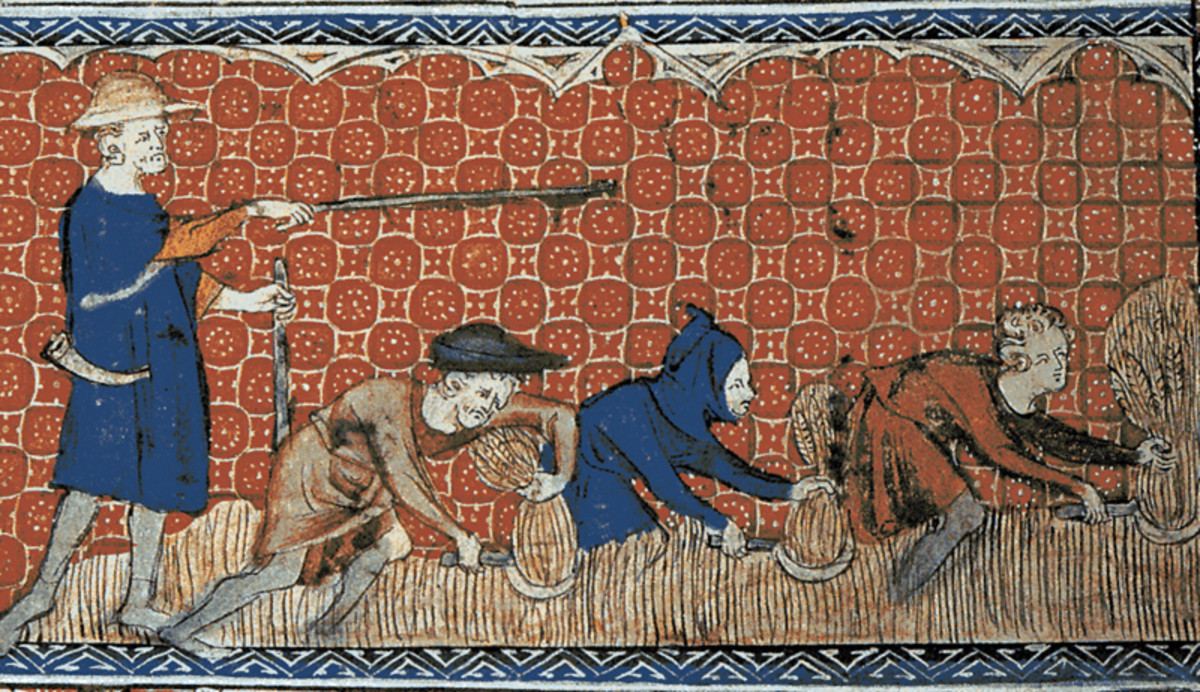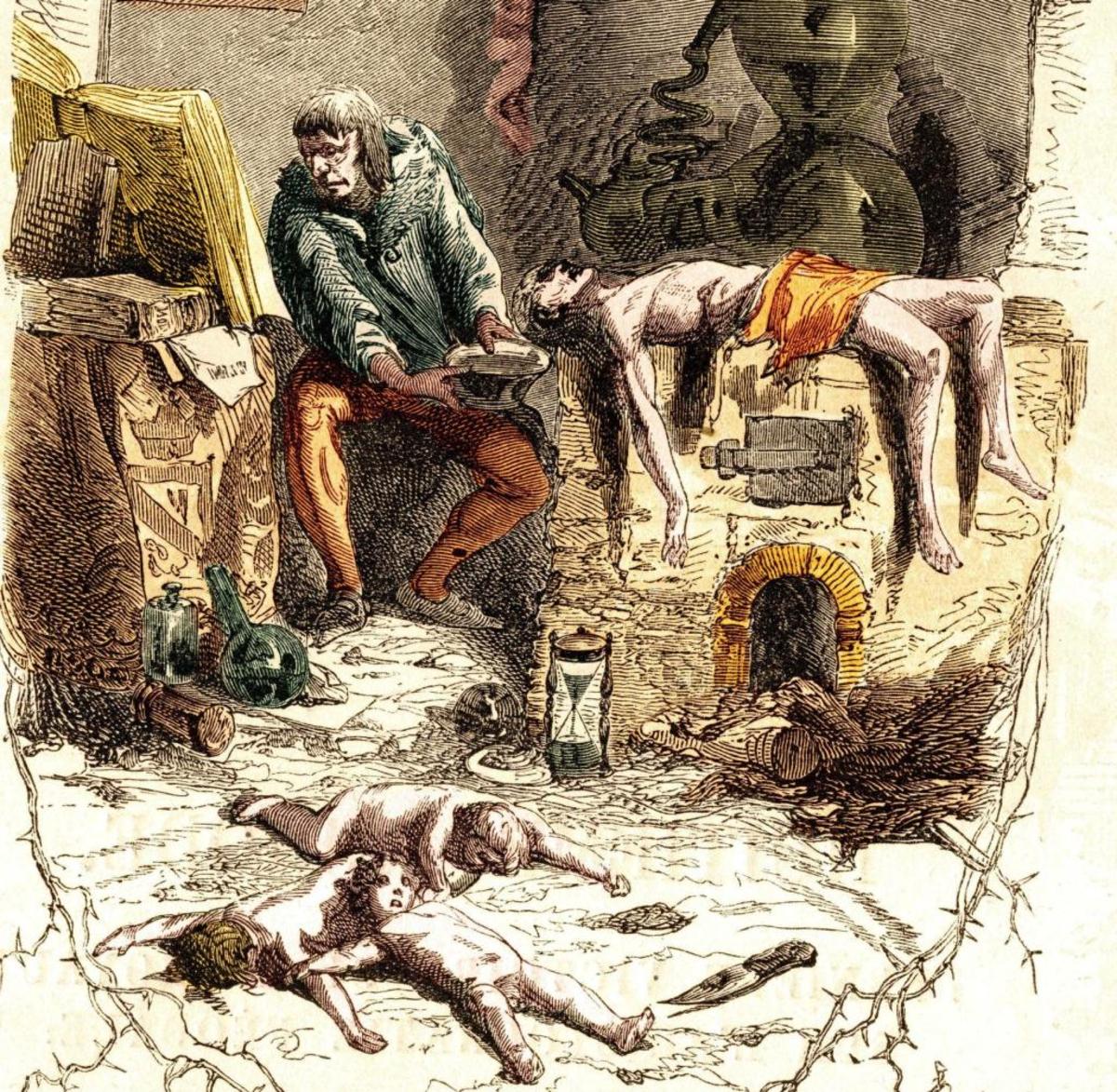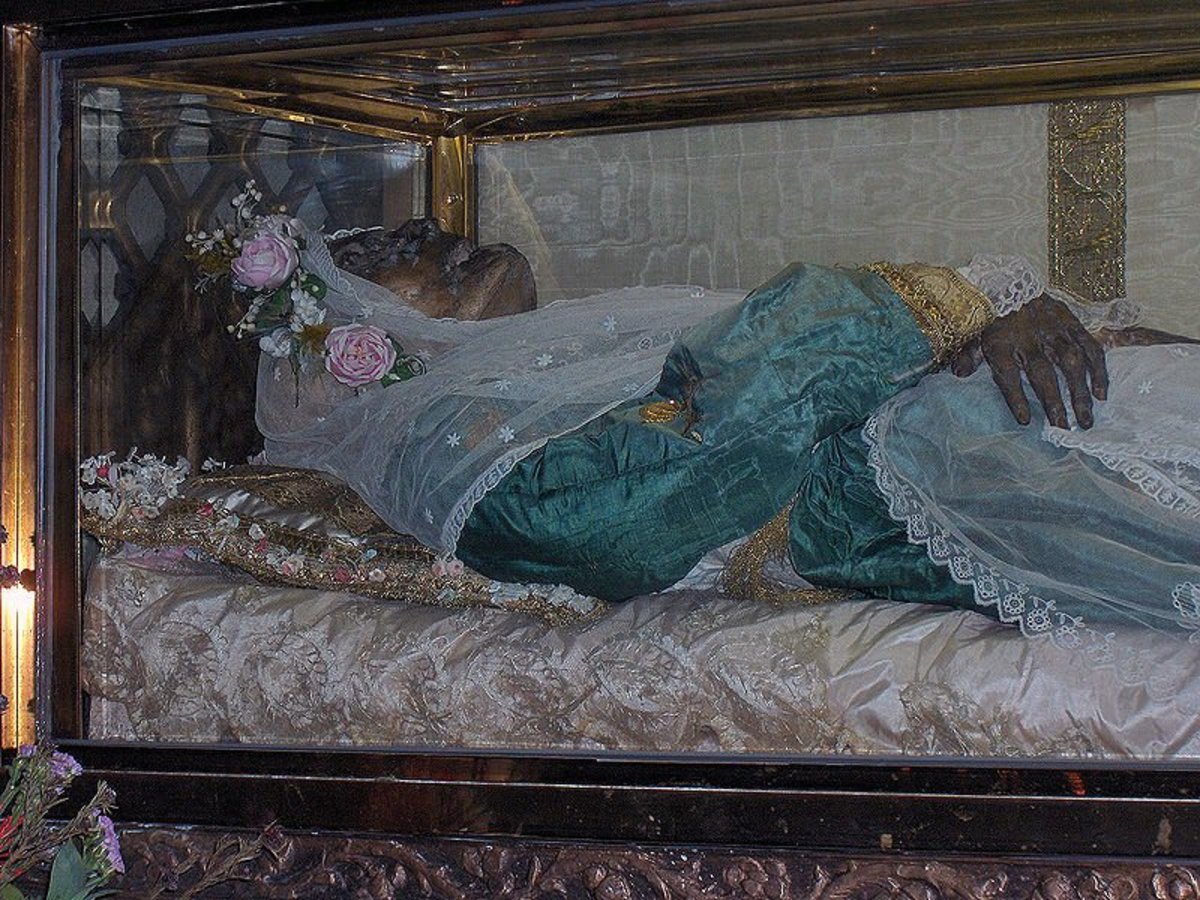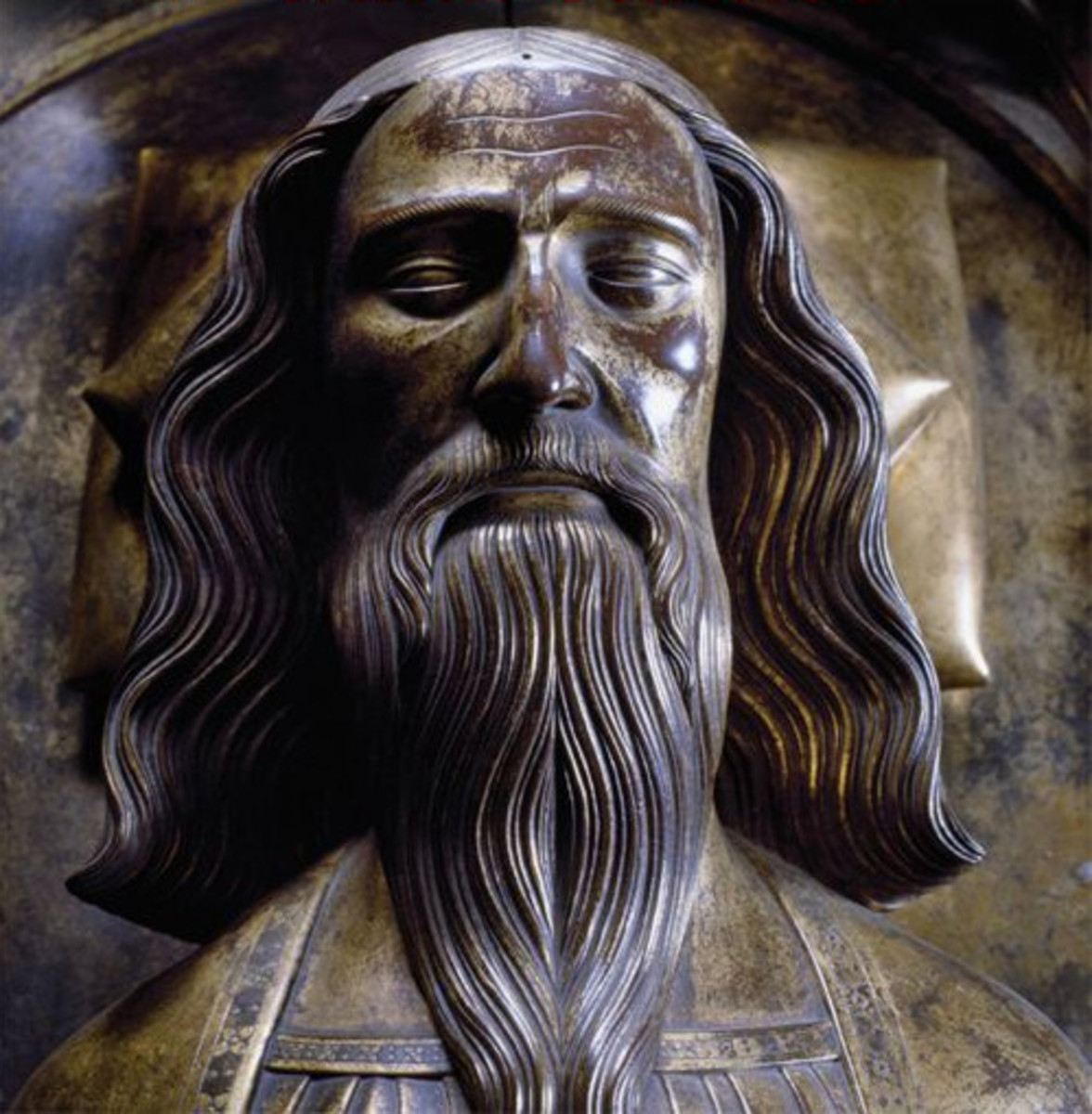Age of Heroes - 5: A King's Call - the Oath of Duty to a Head of State in Wartime
With a change of leadership would come a change of loyalties. Eoferwic would become Jorvik, the new masters were Danes and they ruled well. Jorvik prospered
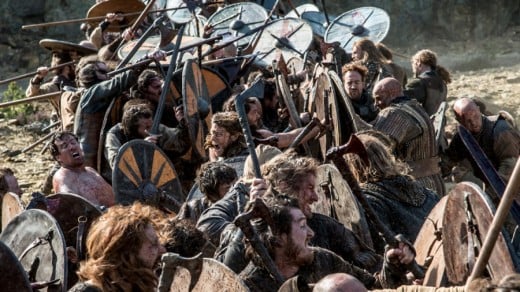
Should the need arise, fit younger men had to be ready to fight.
Be it for their king or lord, ultimately defeat might lead to loss of life or worse - loss of freedom might mean to be sold as thralls in faraway markets, alone, separated from kin or friends. As kingdoms settled in and once-warring neighbours accepted one another everyone became used to a more sedentary life.
Trades were pursued, land- and animal-husbandry and only standing armies were needed. Here and there fighting erupted between newcomers and Gallo-Celtic neighbours and a need to maintain at least basic training for a general call to arms persisted. Yet the broad masses were only of limited value on the battlefield, to make up numbers, hopefully bluff the enemy out of a fight. The desired effect of a mass of bodies was that the less numerous side would back away and bloodshed would be averted.
If blows came to blow. however, the 'masses' were there to withstand pressure in the shield-wall. With the growth of kingdoms a more selective form of defence could be relied on to stay a neighbour's desire for land-grabbing. Each Wessex Hundred - the land divisions of that kingdom - could be called on to support their chosen defenders by means of supply. Land workers were then free to pursue their given tasks, perhaps produce a surplus with which the king or lord could afford better weapons (sounds familiar?). This in turn led to trade with the outside world.
Acquisition of better armament and training would lead to the formation of a superior fighting force, the 'select fyrd', although this reference is a more modern concept. In truth at the time there were few differences between upper and lower levels within the fyrd system. Much of what we know of the fyrd system, fyrdfaereld, comes from Domesday. Little information is available from the Saxon chronicle sources. The Normans kept the system for purposes of taxation, as it directed their attention to the supporting administration.
This state of affairs was not uniform throughout the kingdom after the time of Aethelstan. There were differences with former Danelaw and Northumbrian shires, which applied the Danish wapentake government system and land measurement, the carucate instead of the hide. The law was also administered differently and thus also the nature of military obligation.
From the former Wessex the Berkshire Domesday tells us:
"If the king sent out an army, one warrior went from five hides, each hide furnishing fou shillings towards his wages and upkeep for two months".
A hide was a unit of land considered enough to support a man and his family. In reality the hide was not fixed in size, differing according to the quality of soil in different districts. In Berkshire this measured about forty square acres. By the Conquest the hide became an administrative term rather than a fixed land measurement. The calling of one armed man from each five-hide unit stems from early times, a basic shire division. Twenty units made up the Hundred, also a military sub-unit, as the twenty men raised from each Hundred may have fought side-by-side more than once.
In the 10th Century the fortunes of Wessex changed enough for the king to cast his eyes northward. Here thegns who had held their land from Danish lords and new landholders of Norse descent were drawn into a slightly different system. The unit of assessment for military duties in the Danelaw and southern Northumbria - Deira, now Yorkshire and Lancashire - was the carucate, of unknown size but likely to have been the same as a hide. Stamford in Lincolnshire, one of the Five Boroughs, was assessed at 150 carucates, giving an obligation of thirty men to bear arms for the king/jarl. Another northern administrative division was the vapnatak or wapentake (weapon-take, still used as council divisions in Yorkshire until fairly recently), which showed the district's obligation to supply weapons to the men assigned for defence.
The five-hide system has parallels with the system of levying armed men used by the Franks. A capitulary (law) issued by Charlemagne in AD807 tells us that:
"Each freeman who holds five mansi shall likewise be called on for the defence (of the kingdom)"
A mansi or household (from where the word 'manse' stems) was the Frankish equivalent of the English hide. The common roots of Germanic origin are plain here, and a reaction to similar events. It is equally likely Anglia, Jutish and Saxon kings copied from the Carolingian model, so it would hardly be coincidental to find two systems of conscription so alike.
Fyrdmen, the background
The law of Ine (Wessex) speaks of the rank and file in the General Fyrd as ceorls, the common men.
Bede in the 7th Century also hinted that ceorls served as fighting men when he bemoans a trait amongst men of all standing in Northumbria to take the cloth. The gesith and later thegns had a mainly supervisory role in the General Fyrd, the 'select fyrd' as we understand the upper level of early mediaeval society was different in that it called on few ceorls and drew more on thegns. The greater number of thegns in the 'select fyrd' is mentioned especially by Abbot Aelfric of Eynsham. He saw society in the early 11th Century aligned in three orders:
"those who laboured, or ceorls and craftsmen; those who prayed, the clergy, and those who fought, the thegns".
The general fyrd in England, who made up the greater part of the fighting orders during the 1066 campaigns would have been made up of thegns and an unknown percentage of higher freemen, ceorls or craftsmen.
Huscarls
Brought to England by Knut, the huscarls served kings until Harold's time. The term basically means 'household man' and the standing of these 'huscarlar' was similar to that of 'hearthweru' in the early days of the Anglian and Saxon kings. First mention of the 'huscarls' was from a late Icelandic source, 'Flateyjarbok', described as the warriors introduced in the early 11th Century. The more reliable Saxon Chronicle stipulates that when Knut disbanded his army in AD1018 he kept the crews of forty ships as his own household retinue. He had ruled England from the death of his father Svein 'Forkbeard' Haraldsson, and his trusted huscarls took over from the role previously held by West Saxons of the royal household. In later years Danes and Englishmen alike were drawn into this elite body of warriors. The East Norse (Danish and Svear or Swedish) tongues were close enough for them to understand one another and form mixed units.
The huscarls performed much the same functions as king's thegns, they could be allocated to administrative tasks by the king and were often landholders like the thegns in the shires. Earls would have their own huscarls, as did Earl/King Harold's younger brothers Tostig, Gyrth and Leofwin, and were shown in the Bayeux Tapestry alongside the latter two. Domesday shows huscarls to be landholders after they were no longer a military entity.
It is not recorded whether huscarls were paid on a regular basis as retainers, as few documents survive from the time. Their rewards may have been in the form of gifts rather than by coin. However, greater numbers of paid men were maintained by the royal household by the 11th Century and it is not wholly unlikely the huscarls were a force paid from the king's purse.
In AD1094 William 'Rufus' summoned the fyrd for overseas duty but disbanded before crossing the Channel, taking ten shillings from each thegn in place of service.This money may have been part of twenty shillings needed by the Berkshire Domesday to be provided for each member of the fyrd to keep him in the two months stipulated by law. The money seems to have been used to support paid men - a more widespread practice by this time in European warfare.
Thegns and their Weaponry
Writing around AD98 Tacitus mentioned of the Germani - the forefathers of the Saxons they employed as foederati - that all men were expected to bear arms and to know their use.
Youths were given shield and spear by the chieftain or by close kindred as part of the passage from childhood to manhood. Chieftains gave further weapons as tokens to valued warriors - partly from plunder gained by raiding parties. The acquisition of weapons thus became closely associated with oaths of fealty to the lord and were part of the binding that held together the Germanic warband. Especially valued gifts are mentioned in BEOWULF, given to the hero by Hrothgar the king of the Danes in thanks for ridding him of Grendel. In addition to a hugely expensive sword, Beowulf was given a golden standard, helmet, byrnie and eight wargorses with gilded bridles. On one of the horses was strapped a skilfully decorated saddle inset with precious stones that had been the king's own.
Although gifting may have been the usual way for a thegn to acquire weapons, the same would not have been done for fyrdmen, who were expected to bring along their own weapons. There were items that the Hundred would supply them with such as perhaps shield and spear. In the Danelaw and north of the Humber the Wapentake supplied basic equipment.
In the 11th Century the Laws of Aethelred refer to the likelilhood of a ceorl, even if he owned a helmet, mail shirt and sword, not being the equal of a thegn unless he owned five hides of land. When a thegn died his heirs were expected to give the king a gift for their right to the thegn's landholding to be confirmed. The gift normally took the form of weapons and other fighting gear, although this could be replaced by coin of the realm. In this way the king lost nothing by the death of a thegn. The weaponry, however, could be re-issued to under-equipped fyrdmen, or to paid men hired directly by the king.
By the end of the 10th Century the heriot of a king's thegn was laid down as four shields, four spears, four horses - two saddled - two swords, a helmet and coat of mail. This would equip a small company of fyrdmen, one being well kitted-out and the other two being riders. The un-saddled mounts would hve been the spare horses led by attendants armed only with shield and spear. This small company would have been the fore-runner of the later mediaeval lance, i.e., under a lance corporal.
Next - 6: The Way of the Warrior
Ready for the clash of arms
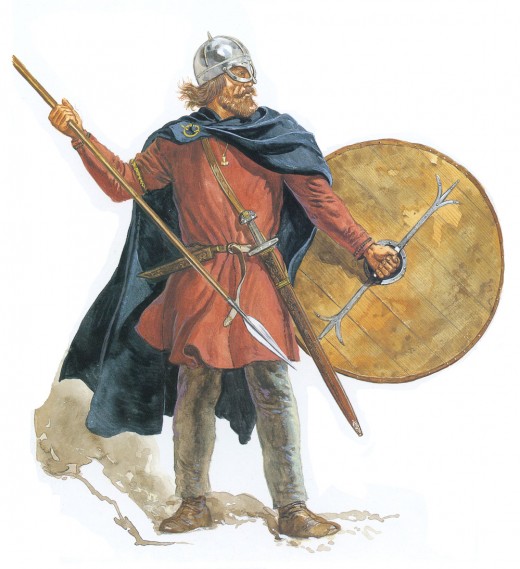
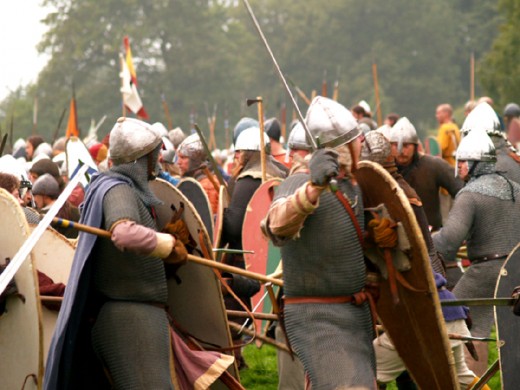
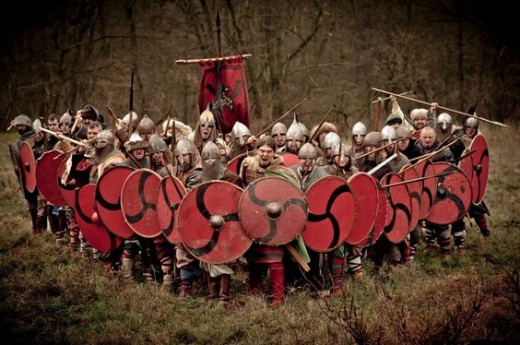
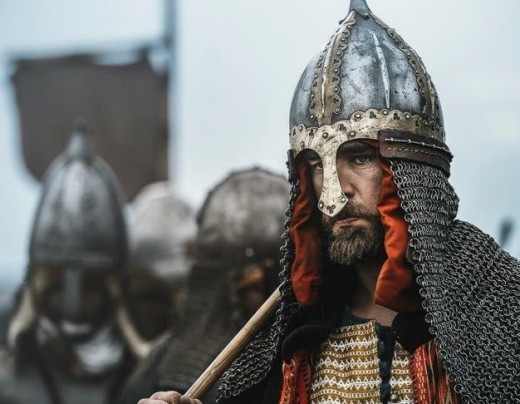
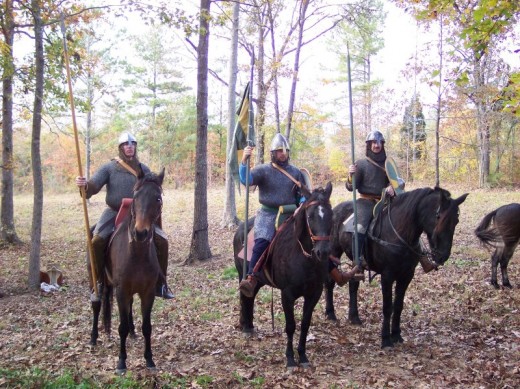
Amongst men of standing
...a man's word was his bond. If he gave his oath to the king that he would serve him 'unto death', the oath would be taken at face value. If the king, or ealdorman, stallari (marshal), shire reeve or thegn took a man at his word there was no room for manoeuvre. Only death was the way out, either of the oath-giver or oath-taker.
Treason was taken very seriously, death being the only fit punishment, and so it has been down the centuries. Death is still the punishment on the statutes in the UK for treason, although it has not been enacted in the last half-century.
When a king went to battle his oath-givers - from ealdorman/earl down to huscarl later on - went with him and if necessary died with him unless they were saved - as was Ansgar 'the Slaller', shire reeve of Middlesex who fought in Harold's shieldwall on Caldbec Hill near Hastings. He fought against William again within weeks at London Bridge, on the winning side. He later found himself having to give his oath to William by virtue of his standing as shire reeve. He was replaced within a short time, however, and no record of him is available after 1068.
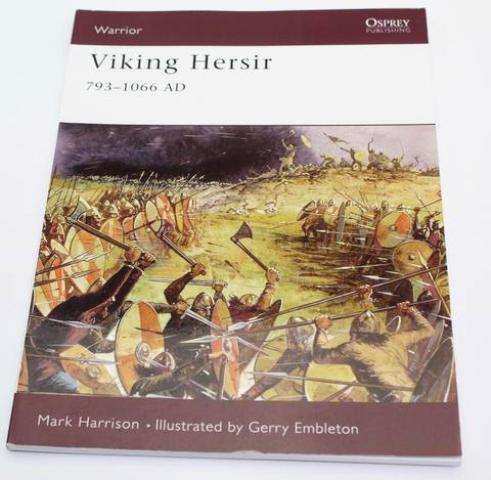
A different, more mobile kind of warfare, different thinking that was adopted by the Angles and Saxons after the Danes first came looking first for vengeance for the death of Ragnar 'Lothbrok', then for land. They used horses to get about when they were away from their ships, as in Guthrum's winter attack on Aelfred at Chippenham. Their Norse neighbours were organised otherwise, although they also fought hard, using the shieldwall as a defence formation in the way the Danes did... Narrative by Mark Harrison, illustrations Gerry Embleton with monochrome photographic illustrations and diagrams
© 2012 Alan R Lancaster

